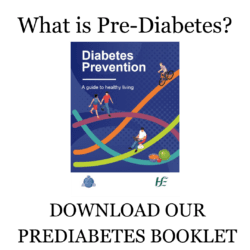Pre-diabetes is when the amount of glucose (sugar) in the blood is too high but not yet high enough to diagnose Type 2 diabetes.
If you have been told you have pre-diabetes you are at risk of developing Type 2 diabetes. It is possible to delay or prevent the onset of Type 2 diabetes by having a healthy balanced diet, taking regular physical activity and aiming to have a weight that is appropriate for your height.
If you are told you have pre-diabetes you should get your bloods repeated in six months to check for Type 2 diabetes. Pre-diabetes is also a risk for heart disease, so you need to get your blood pressure and cholesterol checked also and ensure you don’t smoke.
How do I know if I am at risk of Prediabetes?
If you develop pre-diabetes you will not experience any symptoms. The following are some things that increase the chance of pre-diabetes & Type 2 diabetes developing:
- Having a family history of Type 2 diabetes
- Ageing (over age 40), risk increases with age
- Being overweight for your height (especially around your waist)
- Not taking enough physical activity
- Having previously had gestational diabetes (diabetes during pregnancy)
- Having high blood pressure or high cholesterol
If you have these risk factors it is a good idea to get routine blood tests with your GP to check your blood glucose and rule out pre-diabetes or Type 2 diabetes as it is possible to have Type 2 diabetes and yet not experience any symptoms.
How to measure your waist circumference
-
- Expose the skin around your middle.
- Put your finger at the top of your hip bone, hold the start of the tape measure there.
- Bring the tape measure all the way around your body, level with your belly button.
- Make sure it’s not too tight and that it’s straight, even at the back.
- Breathe normally while doing Step 1 to 4.
- Breathe out and check the number on the tape measure right after you finish the exhale.
For good health it is recommended that your waist measurement is:
Females: less than < 32 inches or 80 centimeters
Males: less than < 37 inches or 95 centimeters
If your measurement is above this, you may want to talk with your doctor about what your next steps are, including losing weight. Download our booklet for more details on the steps you can take
How do I get a diagnosis of Prediabetes?
Pre-diabetes is easily detected with a routine blood test with your GP to measure the level of glucose in your blood. The glucose level can be measured by doing a fasting blood test or a HbA1c blood test or an oral glucose tolerance test. The results will indicate if your blood glucose levels are within the normal range, the pre-diabetes range or the Type 2 diabetes range. The blood tests may also be repeated on a different day.
Fasting blood glucose test: This test is taken in the morning following an 8 hour fast. If this is elevated your GP may order additional blood tests on a different day.
HbA1c blood test: This test measures your average blood glucose for the previous 3 months.
You do not need to fast for this blood test. It is a routine blood test for anyone who has Diabetes.
Oral Tolerance Test
The Oral Glucose Tolerance Test is a two-hour test that checks your blood glucose levels before and 2 hours after you drink a special sweet drink. You need to fast overnight before the test. Diabetes is diagnosed if the fasting glucose level is equal to or greater than 7.0 mmol/l and/or the 2 hour result is equal to or greater than 11.1 mmol/l.
Can I stop Prediabetes becoming Type 2 Diabetes?
Prediabetes does not always lead to Type 2 Diabetes, many people will be able to delay or prevent Type 2 diabetes from developing by;
- Healthy eating
- Taking regular physical activity
- Aiming to be a normal weight for your height
Download Living well with Pre-diabetes booklet for more details on the steps you can take
Visit Diabetes SMART an online course you can do at home at your convenience to learn about pre-diabetes, healthy eating and physical activity.
Ensure to ask your GP when you should attend for repeat blood tests to check your glucose level. Your body will not warn you if you develop Type 2 diabetes.







